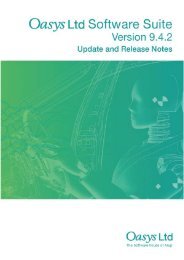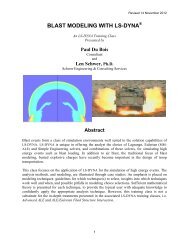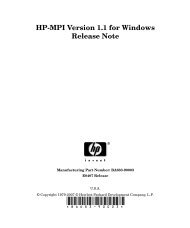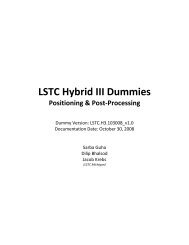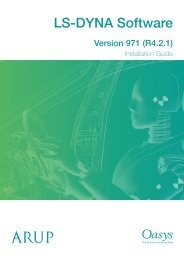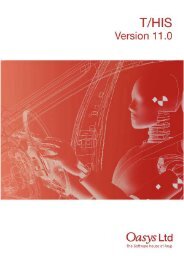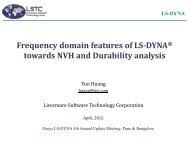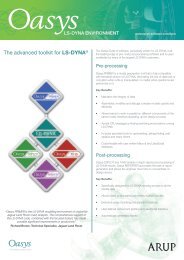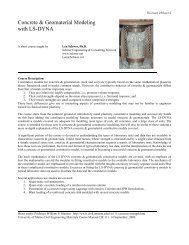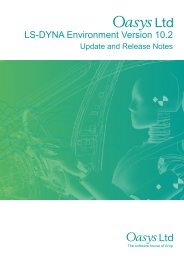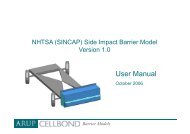Oasys LS-DYNA Environment 8.1 VOLUME 3 ... - Oasys Software
Oasys LS-DYNA Environment 8.1 VOLUME 3 ... - Oasys Software
Oasys LS-DYNA Environment 8.1 VOLUME 3 ... - Oasys Software
You also want an ePaper? Increase the reach of your titles
YUMPU automatically turns print PDFs into web optimized ePapers that Google loves.
<strong>Oasys</strong> <strong>LS</strong>-<strong>DYNA</strong> <strong>Environment</strong>: User Guide (Version <strong>8.1</strong>)<br />
model of interest is *MAT_POWER_LAW_PLASTICITY which allows the commonly used<br />
parameters n & K to be used directly; these are often available from the material supplier, and<br />
n is critical in assessing the forming limit of the material. This model also includes strain rate<br />
sensitivity (but see discussion below on scaling tool velocity). As with all material models in <strong>LS</strong>-<br />
<strong>DYNA</strong>, work hardening data must always be based on true stress vs. true strain values.<br />
Generally, splits in a blank occur due to a strain limit defined in the plane of the sheet by a<br />
forming limit curve. It is most convenient to assess splitting by post-processing, comparing<br />
values with the forming limit curve (e.g in <strong>Oasys</strong> D3PLOT) rather than attempt to include failure<br />
in the analysis.<br />
TOO<strong>LS</strong><br />
The tooling surfaces (punch, die, upper and lower rings, etc.) are usually represented by rigid<br />
elements, typically shells, although in some cases where flexibility of the blank holder ring is<br />
important it is worth considering modelling the ring with elastic solids (with obvious cpu<br />
penalties); Rigid to Deformable switching can sometimes be useful here. The rules on mesh<br />
generation for tool surfaces are more flexible than for deformable parts; the mesh does not have<br />
to be continuous and can use high aspect ratio elements for example, but this may put excessive<br />
demands on the contact surface. It is important, however, that the intended geometry is<br />
accurately represented. Small radii require small elements and at least five elements around a<br />
90b radius are recommended. Automatic mesh generation techniques that modify the element<br />
size according to the geometry are very useful for creating tool models; eta\<strong>DYNA</strong>FORM has<br />
a powerful tool mesh generator.<br />
<strong>LS</strong>-<strong>DYNA</strong> offers the option to use CAD data directly to represent the tools; both IGES and VDA<br />
databases are supported. The VDA option has generally been the most effective mostly because<br />
of the wide variation in IGES definitions. Use of CAD data gives the most accurate<br />
representation of the tooling surfaces as no discretisation of the geometry is required (a coarse<br />
mesh is generated automatically for ease of post-processing - this is not used in the calculation).<br />
Springback prediction will also be improved as stresses are more accurate. This option offers<br />
significant time savings in model creation but does require high quality, fully trimmed surface<br />
definition with no overlaps and very small gaps. It is also often more demanding on cpu. The<br />
file containing the location CAD data must be identified in the <strong>Oasys</strong> submission shell; an alias<br />
must be defined on each *PART card to identify which file is the die, which the punch etc.<br />
Options in <strong>LS</strong>-<strong>DYNA</strong> associated with use of CAD data include the ability to translate the surface<br />
to its initial position and a function to create one tool from another by a normal offset.<br />
Implementation is by means of aliases on each *MAT_RIGID card together with a file<br />
identifying which surfaces are associated with which alias (this file can be specified using the<br />
Additional Files option in the <strong>Oasys</strong> submission shell). The syntax for this file is given in the<br />
user manual; see Appendix I for more details.<br />
TOOL MOTION<br />
Page 17.3



